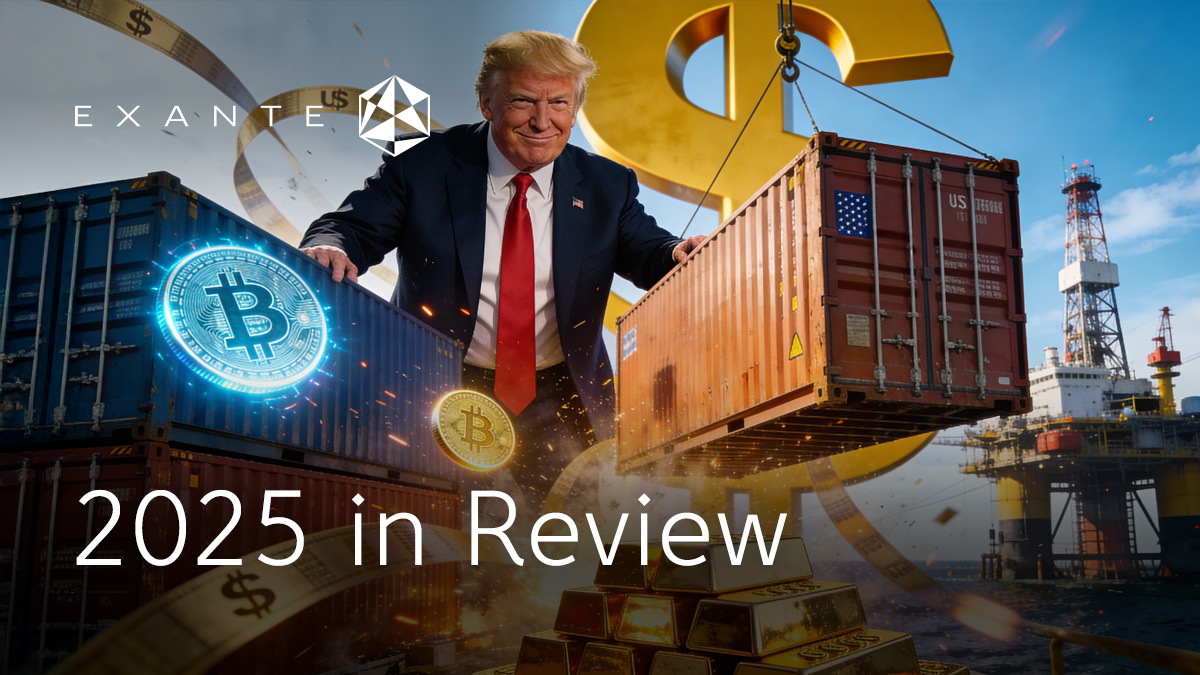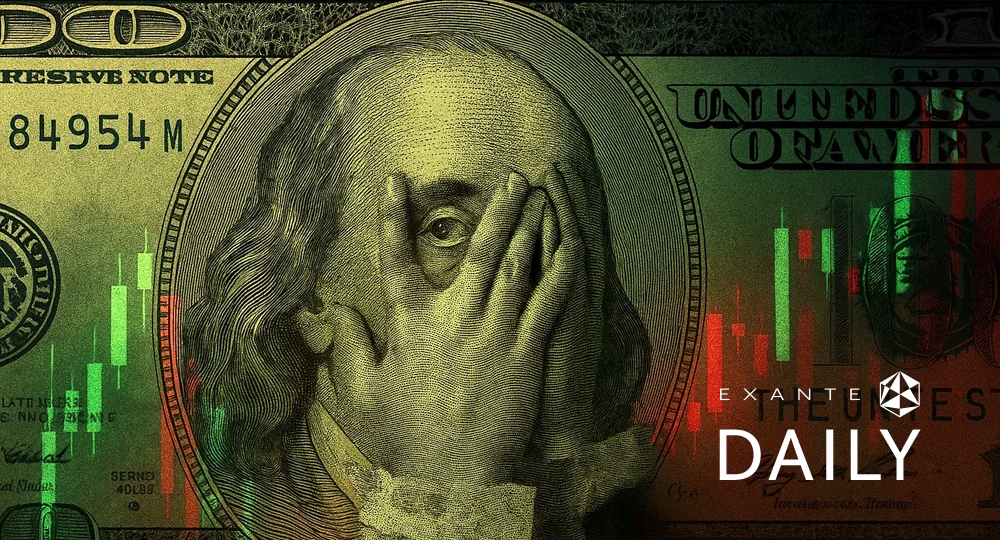
EXANTE Monthly Macro Insights

By Renée Friedman, PhD
The month in summary
Welcome to Monthly Macro Insights for April 2022. China's COVID-19 closures and the threat of a growth slowdown, the ongoing crisis in Ukraine and Europe’s energy crisis as supplies from Russia are cut, and fears of aggressive US Federal Reserve tightening continued to dampen risk appetite and lifted the dollar to new two-year highs in April.
In the US, Germany and the UK bond yields have trended upwards in April as investors react to hawkish remarks from the US Fed. The ongoing situation in Ukraine and the threatening economic slowdown in growth globally has also depressed bond prices.
Global stock markets also fell in April with technology and other growth sector stocks being most affected. The S&P 500 was down about 7.7% MTD and down about 12% YTD, the Nasdaq was down about 12.1% MTD in April and down about 20.1% YTD, and the Dow Jones industrial Index was down about 4.2% MTD and 8.5% YTD. In Europe the STOXX 600 was down about 2.5% MTD (8.9% YTD), the DAX was down 4.3% in April (13.2% YTD), the CAC40 was down about 3.2% MTD and 9.9% YTD, the IBEX35 was up about 0.4% MTD and down 2.7% YTD, the FTSE MIB was down 4.8% MTD and down 12.9% YTD, and the FTSE 100 was down about 1.2% MTD and up approximately 0.6% YTD. The MSCI World Equity index was also down in April by about 8.1% and YTD was down about 13.4%.

Market volatility index April source: Refinitiv
Despite concerns that the US is headed towards a recession as the Fed’s history of being able to engineer a “soft landing” is not very good, the data has continued to be supportive of the economy’s ability to withstand an aggressive rate hike trajectory with Inflation in the US does differ from that experienced in Europe and the UK; in the US it is both supply and demand driven (wages in the US are up nearly 6%) whereas the European and UK inflation trajectories are largely due to supply issues: nearly three-quarters of the euro zone’s inflation is attributable to surging energy and food prices. In the US an overlooked positive for economic growth is the fact that capital spending remains intact, Core capital goods orders increased 1.0% in March and Durable goods orders rebounded 0.8%. However, consumer confidence dipped in April. The trade deficit in goods widened to a record high in March as companies front-loaded imports over concerns about supply constraints due to the situation in China and shortages in commodities due to the crisis in Ukraine.
April saw the ECB take a slightly more hawkish tone as inflation across the Eurozone hit 7.4% in March. According to ECB President Christine Lagarde, the ECB’s net asset purchases are likely to end in July or August with interest rates then rising later in the year She said during several interviews during the IMF-World Bank Spring meeting, that “the end of bond buying is very likely to happen in the course of the third quarter with a high probability that it will be early in the quarter if numbers continue to be the way we have seen them, but we have to be data dependent." This more aggressive tone towards fighting inflation has been supported by other ECB members including Martins Kazaks, Governor of the Latvian central bank. He said “a rate rise in July is possible and reasonable…markets are pricing two or three 25 basis point steps by the end of the year. I have no reason to object to this, it's quite a reasonable view to take and whether it happens in July or September is not dramatically different, but I think July would be a better option." Kazaks said that as part of normalisation, the ECB should eventually raise interest rates to the neutral rate. Various estimates put this rate at 1% to 1.5%, well above the current -0.5% deposit rate and its main refinancing rate, stuck at zero. Investors have been betting that the deposit rate, which has been negative since 2014, will rise above zero this year However, the labour market remains strong in the Eurozone and wage growth, a key requirement of durable inflation, is still muted according to ECB Vice President Luis de Guindos. Eurozone unemployment reached new lows at 6.8% in February.
The IMF in its new global growth forecasts revealed last week forecasts UK inflation to remain stuck above 5% into 2023 and for growth to be the lowest among the G7 economies. The UK has a very tight labour market with unemployment running at 3.8%, 0.1% below its pre pandemic levels. However, it is also suffering from the same supply shocks plaguing Europe. In short it has both a supply and demand problem pushing inflation but limiting growth, i.e. the risk of stagflation is a very real one for the UK. The Bank of England (BoE) looks set to take its first steps next week towards selling some of the £875 billion of government bonds it amassed between 2009 and 2021 according to Refinitv. The BoE is walking a"very tight line" between tackling inflation that is way above the BoE's target and not triggering a recession. The BoE is expected to raise interest rates on 5 May. Financial markets have fully priced in a quarter-point rise in the bank rate to 1.0%. That 1% level is the level at which it has previously said it will consider outright bond sales. If that is indeed still the case, the big question will then be when these sales will start. Analysts' estimates range anytime from June 2022 well into 2023. However, a reduction in gilt holdings has the potential to push up borrowing costs across the economy as liquidity is reduced throughout the financial system. This unwinding of the balance sheet along with rate rises could threaten financial stability if there is a sudden credit crunch if actions are taken too quickly. It would essentially be the first reversal of the QE policies most major central banks have been engaged in since the 2008-09 Financial crisis. The other option is simply waiting for the gilts it owns to mature (i.e. a run off the balance sheet) but this, according to Refinitiv, would take until 2030 for the BoE's holdings to return to their pre-pandemic level and 2071 for final gilts to roll off the BoE's books.
The expectations on growth prospects and rate rises have hit currencies. Month to date (MTD) the euro has fallen about 4.7% against the USD and is down about 7.2% year to date (YTD), the GBP has fallen about 4.5% MTD and about 7.3% YTD. The Japanese Yen has strengthened about 5.6% against the USD on a MTD basis and 11.6% YTD, and the CHF is also up almost 5% MTD and 6.2% YTD.
Oil markets have had a volatile month in April. Although demand in China slowed, the ongoing concerns about tight worldwide supply, reinforced by a reduction in US distillate (crude stocks rose by just 692,000 barrels last week according to Reuters, which was short of expectations, while distillate inventories, which include diesel and jet fuel, fell to their lowest since May 2008. The decision by Russia to cut gas supplies to Bulgaria and Poland as they refuse to pay in Rubles, has markets, particularly in Europe which is highly dependent on energy supplies from Russia, even more worried.

Brent Crude futures March 2022 source: Refinitiv
Things to look out for this coming month
Beyond the continuing Ukrainian-Russian crisis that threatens to intensify, the slowdown in China and , there are other considerations that may affect global geopolitics and economics including:
3-4 May US Federal Reserve Monetary Policy meeting. Markets have priced in a 50 basis point rate rise given the more hawkish tone of the Fed in recent weeks. The 8.5% inflation rate in March, the highest in over 40 years, is, as noted in The Economist, forcing the Fed policymakers to prepare the sharpest tightening cycle in decades.
5 May Bank of England Monetary Policy meeting. The Bank of England (BoE) has lifted its policy rate 3 times to 0.75% and is expected to lift it to 1% at its May meeting. inflation has accelerated to 7%, more than three times the BoE's target and is on course to hit 10% this year. However the economy is also starting to slow down, deepening the BoE's dilemma. Governor Andrew Bailey has said "We are now walking a very tight line between tackling inflation and the output effects of the real income shock, and the risk that that could create a recession," Rate futures are pricing the bank rate hitting 2.25%, but the weakening economy is hitting the Pound Sterling.
9 May Philippines Presidential Election. The son of former President (and dictator) Ferdinand Marcos, Ferdinand “Bongbong” Marcos Jr., is leading in the polls to become the next president. The geopolitical shift by current President Rodrigo Duterte away from its traditional ally, the US, and towards China, means this election will be important as tensions in the South China Sea continue despite the 2016 ruling on the South China Sea dispute. At that time the international tribunal in the Hague dismissed China’s claims and ruled that specific portions claimed by both countries belonged to the Philippines alone.
18-20 May G7 Finance ministers meeting. The finance ministers and central bank governors of G7 countries will meet in Germany to discuss global financial issues.
22-26 May World Economic Forum’s Annual Meeting. Topics on the agenda will include the pandemic recovery, tackling climate change, building a better future for work, accelerating stakeholder capitalism, and harnessing the technologies of the Fourth Industrial Revolution.
29 May Colombia Presidential Election. Colombia could, for the first time, elect a leftist as President when it goes to the polls on 29 May. Gustavo Petro, a leftist and former M-19 guerrilla member, won the primary in March. However, if there is a second round on 19 June (this will happen if a candidate fails to win over 50 percent of votes in the first round), he may not win if there is a solid centrist candidate. The other two Presidential candidates from the primary are right-winger Frederico “Fico” Gutierrez and centrist Sergio Fajardo. However, two popular presidential candidates skipped the primaries: centrist former Senator Íngrid Betancourt, a former hostage of the Revolutionary Armed Forces of Colombia (FARC), and conservative anti-establishment businessman Rodolfo Hernández. Regardless of who wins, Congress is very divided with more than a dozen parties in the lower house alone which will make it difficult to build a coalition. There is still the issue of a floundering peace agreement that the new president will have to deal with as well.
Batten down the hatches, there appears to be a storm on the horizon
Although the IMF has lowered its forecast for growth in Europe, the UK and the US, many investors are still acting as if we have now passed peak inflation and that the major central banks will be able to engineer a soft landing for everyone. Despite years of extra liquidity being pumped into the market and a QE reversal never actually happening, (so we are on new ground here) it seems markets are unprepared for the economic cycle to turn now that this liquidity is being removed (more quickly in some markets than others).
The real question is whether it is investors or forecasters who are more correct in their views. The global economy does, based on the data, appear to be heading into a perfect storm, with Europe, China, and the United States all entering downturns at the same time later this year if 1. Europe’s energy supplies become further reduced and markets remain risk off as the events in Ukraine intensify and possibly spill over into NATO and EU countries, 2. The Chinese government is unable to provide sufficient support to overcome the effects of the Covid lockdowns and 3. Other inflationary factors such as supply chain problems continue. Maersk, one of the largest global container shipping companies in the world, recently downgraded its forecasts. The Financial Times reported on 26 April that Maersk has now forecast container demand — a proxy for global trade growth — to be between 1 per cent growth and a 1 per cent decline this year, against previous guidance of a 2-4 per cent increase.
As noted by Kenneth Rogoff, a Harvard University professor and former chief economist at the IMF, a recession in Europe is highly likely, China is finding it increasingly difficult to sustain positive growth, and in the US the prospects for a soft landing for prices without a big hit to growth look increasingly remote. Given the interlinkages between these economies, a collapse in one region will raise the odds of collapse in the others.
So where may there be some calm(er) ports in the storm? This new world of rising rates and greater geopolitical threats (to supply chains, to trade, and to growth) may require greater selectivity and a rebalance toward value stocks and stocks of companies with strong balance sheets and good cash flows. And, surprisingly, despite having their worst quarter in years, some analysts are suggesting that bonds may be the solution, citing rising yields relative to stocks that are likely to be hit by worsening corporate earnings reports as the economy slows. As Yale professor and former chairman of Morgan Stanley Asia Stephen Roach says, "real interest rates matter in maintaining price stability and driving economic growth. When assessing risks to the global business cycle, the bottom line is that the upswing in real rates has much further to go." So as we look to remain in risk on mode for the foreseeable future, investors will likely need to rebalance their portfolios far more quickly than they may have done in the past.
DISCLAIMER: While every effort has been made to verify the accuracy of this information, EXT Ltd. (hereafter known as “EXANTE”) cannot accept any responsibility or liability for reliance by any person on this publication or any of the information, opinions, or conclusions contained in this publication. The findings and views expressed in this publication do not necessarily reflect the views of EXANTE. Any action taken upon the information contained in this publication is strictly at your own risk. EXANTE will not be liable for any loss or damage in connection with this publication.
本文提供給您僅供資訊參考之用,不應被視為認購或銷售此處提及任何投資或相關服務的優惠招攬或遊說。金融商品交易涉及重大損失風險,可能不適合所有投資者。過往績效不代表未來表現。




